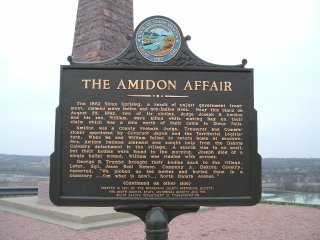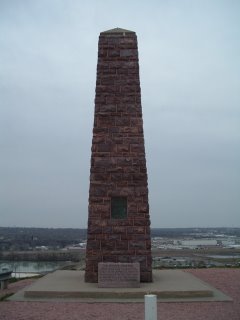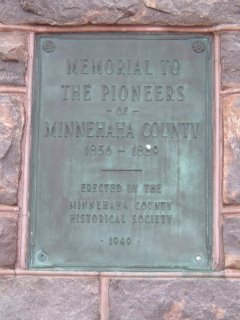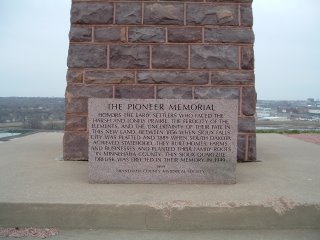The Pioneer Memorial, and The Amidon Affair
This marker is probably one of the grandest in the city, because of its location and because of the monument at the same site. First the story, as told by the markers at the site.

The marker is located on the edge of a bluff overlooking the Big Sioux River (Google Maps satellite view). I don't know why the Amidon's chose this spot for their hay field, but if it were me settling the area back in 1860, I certainly would've built my home there, just for the view. Unfortunately, time and the development of Sioux Falls has not been kind to this spot, for just down the hill to the south is the waste water treatment plant retention ponds and the John Morrell meat packing plant. To the east is Barney's Auto Salvage, an eyesore from the ground and the air. And just around the bend to the west is the South Dakota State Penitentiary. If not for those four facilities, this area would be the most desirable residential property in eastern South Dakota.
I've long wondered what it was about the deaths of the Amidons that made the event worthy of monuments like this, because there were many early settlers who died either at the hands of Indians or any number of other causes. But in reading the story, the event was apparently the catalyst which led to the evacuation and the 3-year abandonment of the Sioux Falls settlement. That was a major event in the history of the city.

The bronze marker is accompanied on the site by a huge granite obelisk that was erected in 1949. A plaque on the monument reads as follows:


The Amidon Affair
The 1862 Sioux Uprising, a result of unjust government treatment, claimed many Indian and non-Indian lives. Near this place on August 25, 1862, two of its victims, Judge Joseph B. Amidon and his son, William, were killed while making hay on their claim which was a mile north of their cabin in Sioux Falls.
Amidon was a County Probate Judge, Treasurer and Commisioner appointed by Governor Jayne and the Territorial Legislature. When he and William failed to return home at sundown, Mrs. Amidon became alarmed and sought help from the Dakota Calvalry (sic) detachment in the village. A search was to no avail, but the bodies were found in the morning. Joseph died of a single bullet wound. William was riddled with arrows.
George B. Trumbo brought their bodies back to the village. Later, Sg. Jesse Buel Watson, Company A, Dakota Cavalry, reported, "We picked up the bodies and buried them in a cemetery ...(on what is now)... North Duluth Avenue."
In the opinion of John Renville and Joseph Laframboise, veteran fur traders and plainsmen, the Amidons were slain by members of the band of the warrior White Lodge. He was under orders from Chief Little Crow, Indian leader in the "Dakota Ware", to drive white settlers from the Sioux Valley. Pure chance placed the Amidons in the path of White Lodge's scouting party.
Two days later, orders came by courier from Governor William Jayne to abandon Sioux Falls and seek shelter at the Territorial Capitol at Yankton. Settlers and soldiers together hastily set out in a wagon train before sundown.
Following the settlers' flight to Yankton, Sioux Falls remained abandoned until the establishment of Fort Dakota by federal troops in 1865, when settlement was resumed.
Joseph B. Amidon was born in Connecticut in 1801. He came to Sioux Falls from Saint Paul, Minnesota, with his wife Mahala, son William and daughter Eliza, sometime before 1860.Erected in 1991 by the Minnehaha County Historical Society, the South Dakota State Historical Society and the South Dakota Department of Transportation.
The marker is located on the edge of a bluff overlooking the Big Sioux River (Google Maps satellite view). I don't know why the Amidon's chose this spot for their hay field, but if it were me settling the area back in 1860, I certainly would've built my home there, just for the view. Unfortunately, time and the development of Sioux Falls has not been kind to this spot, for just down the hill to the south is the waste water treatment plant retention ponds and the John Morrell meat packing plant. To the east is Barney's Auto Salvage, an eyesore from the ground and the air. And just around the bend to the west is the South Dakota State Penitentiary. If not for those four facilities, this area would be the most desirable residential property in eastern South Dakota.
I've long wondered what it was about the deaths of the Amidons that made the event worthy of monuments like this, because there were many early settlers who died either at the hands of Indians or any number of other causes. But in reading the story, the event was apparently the catalyst which led to the evacuation and the 3-year abandonment of the Sioux Falls settlement. That was a major event in the history of the city.

The bronze marker is accompanied on the site by a huge granite obelisk that was erected in 1949. A plaque on the monument reads as follows:
MEMORIAL TO THE PIONEERS
OF
MINNEHAHA COUNTY
1856 -- 1889
ERECTED BY THE
MINNEHAHA COUNTY
HISTORICAL SOCIETY
1949

Another marker, made of engraved granite is mounted at the base of the obelisk, and reads...

Seems odd that the MCHS would see the need to expand on the original plaque on the obelisk. I sometimes fancy the idea of being a settler in this area back in the mid-1800's, but I don't know if I would've fared very well. Those that did were made of tougher stuff, and they deserve our admiration.
The Pioneer MemorialHonors the early settlers who faced the harsh and lonely prairie, the ferocity of the elements, and the uncertainty of their fate in this new land between 1856 when Sioux Falls city was platted and 1889 when South Dakota achieved statehood. They built homes, farms and businesses and planted their family roots in Minnehaha county. This Sioux Quartzite obelisk was erected in their memory in 1949.1999
Minnehaha County Historical Society

Seems odd that the MCHS would see the need to expand on the original plaque on the obelisk. I sometimes fancy the idea of being a settler in this area back in the mid-1800's, but I don't know if I would've fared very well. Those that did were made of tougher stuff, and they deserve our admiration.

0 Comments:
Post a Comment
<< Home